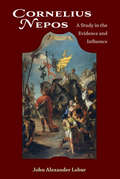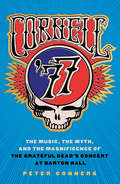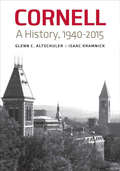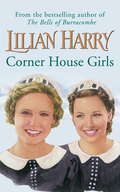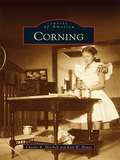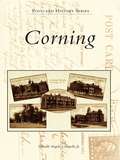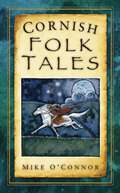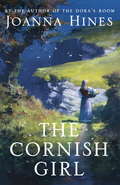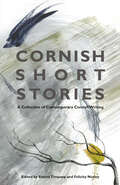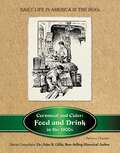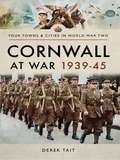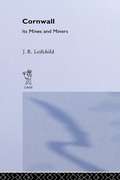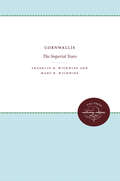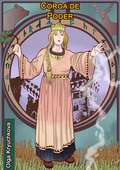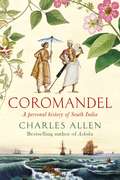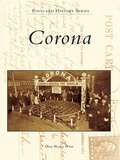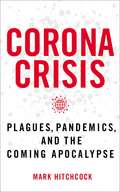- Table View
- List View
Corn and Capitalism
by Arturo WarmanExploring the history and importance of corn worldwide, Arturo Warman traces its development from a New World food of poor and despised peoples into a commodity that plays a major role in the modern global economy.The book, first published in Mexico in 1988, combines approaches from anthropology, social history, and political economy to tell the story of corn, a "botanical bastard" of unclear origins that cannot reseed itself and is instead dependent on agriculture for propagation. Beginning in the Americas, Warman depicts corn as colonizer. Disparaged by the conquistadors, this Native American staple was embraced by the destitute of the Old World. In time, corn spread across the globe as a prodigious food source for both humans and livestock. Warman also reveals corn's role in nourishing the African slave trade.Through the history of one plant with enormous economic importance, Warman investigates large-scale social and economic processes, looking at the role of foodstuffs in the competition between nations and the perpetuation of inequalities between rich and poor states in the world market. Praising corn's almost unlimited potential for future use as an intensified source of starch, sugar, and alcohol, Warman also comments on some of the problems he foresees for large-scale, technology-dependent monocrop agriculture.
Cornelia: Mother of the Gracchi (Women of the Ancient World)
by Suzanne DixonExamining the remarkable life of Cornelia, famed as the epitome of virtue, fidelity and intelligence, Suzanne Dixon presents an in-depth study of the woman who perhaps represented the ideal of the Roman matrona more than any other. Studying her life during a period of political turmoil, Dixon examines Cornelia's attributes: daughter of Scipio Africanus, wife of an aristocrat, and mother of the Gracchi; and how these enabled her to move in high echelons of society. For students and scholars of classical studies and Roman history, this book will give students a glimpse into the life of Cornelia, and of the influence she had on the period.
Cornelius Nepos: A Study in the Evidence and Influence
by John LoburRoman author Cornelius Nepos wrote at a very dynamic time in Roman history, but oddly enough little has been said about what his surviving work as a whole can tell us about that period. In the scholarship of the nineteenth and twentieth centuries, the author was much maligned as inaccurate, simple-minded, and derivative, and thus it has been hard to make the case that the evidence he provides is important or even useful. John Lobur’s work rehabilitates Nepos to show that in fact he should be understood as an emblematic member of the Italian intelligentsia, one well-positioned to write narratives of great potency with respect to the ideological tenor of emerging Roman imperial culture. Cornelius Nepos: A Study in the Evidence and Influence begins by exploring the writer's ancient reception, which suggests he was in no way seen as beneath consideration by the Romans themselves. The volume then deconstructs the critical framework that cast him as an "inferior" author in the classical canon. What emerges is an author who reworked Greek historical narratives in a learned, sophisticated way, yet one still limited by the compositional logistics and limitations inherent in ancient scholarship. The study then explores his contemporary relationships and embeds his work among the crucial ideological activity at play in the late Republic and Triumviral periods. Cornelius Nepos spends considerable time on the fragmentary evidence (which highlights Nepos' interest in changes in fashion and consumption) to suggest that he was a valued cultural elder who informed a public eager to recover a sense of tradition during a period of bewilderingly fast social and cultural change. The book finishes with a thematic examination of the entire Lives of the Foreign Commanders (a set of biographies on ancient non-Roman generals) to show that despite the expression of very “Republican” sentiments, he was in fact fashioning an ideological framework for something imperial and quasi-monarchic which, though autocratic, was still antityrannical and imagined as resting on a broad and “democratic” foundation of social consent. Nepos saw that Rome would soon be ruled by one person, and his biographies show how the elites of the day both processed that reality and attempted to circumscribe it for good ends through the creation of new models of legitimacy.
Cornell '77: The Music, the Myth, and the Magnificence of the Grateful Dead's Concert at Barton Hall
by Peter ConnersOn May 8, 1977, at Barton Hall, on the Cornell University campus, in front of 8,500 eager fans, the Grateful Dead played a show so significant that the Library of Congress inducted it into the National Recording Registry. The band had just released Terrapin Station and was still finding its feet after an extended hiatus. In 1977, the Grateful Dead reached a musical peak, and their East Coast spring tour featured an exceptional string of performances, including the one at Cornell. Many Deadheads claim that the quality of the live recording of the show made by Betty Cantor-Jackson (a member of the crew) elevated its importance. Once those recordings—referred to as "Betty Boards"—began to circulate among Deadheads, the reputation of the Cornell ’77 show grew exponentially. With time the show at Barton Hall acquired legendary status in the community of Deadheads and audiophiles.Rooted in dozens of interviews—including a conversation with Betty Cantor-Jackson about her recording—and accompanied by a dazzling selection of never-before-seen concert photographs, Cornell ’77 is about far more than just a single Grateful Dead concert. It is a social and cultural history of one of America’s most enduring and iconic musical acts, their devoted fans, and a group of Cornell students whose passion for music drove them to bring the Dead to Barton Hall. Peter Conners has intimate knowledge of the fan culture surrounding the Dead, and his expertise brings the show to life. He leads readers through a song-by-song analysis of the performance, from "New Minglewood Blues" to "One More Saturday Night," and conveys why, forty years later, Cornell ’77 is still considered a touchstone in the history of the band.As Conners notes in his Prologue: "You will hear from Deadheads who went to the show. You will hear from non-Deadhead Cornell graduates who were responsible for putting on the show in the first place. You will hear from record executives, academics, scholars, Dead family members, tapers, traders, and trolls. You will hear from those who still live the Grateful Dead every day. You will hear from those who would rather keep their Grateful Dead passions private for reasons both personal and professional. You will hear stories about the early days of being a Deadhead and what it was like to attend, and perhaps record, those early shows, including Cornell ’77."
Cornell, A History, 1940-2015: A History, 1940–2015
by Isaac Kramnick Glenn C. AltschulerIn their history of Cornell since 1940, Glenn C. Altschuler and Isaac Kramnick examine the institution in the context of the emergence of the modern research university. The book examines Cornell during the Cold War, the civil rights movement, Vietnam, antiapartheid protests, the ups and downs of varsity athletics, the women's movement, the opening of relations with China, and the creation of Cornell NYC Tech. It relates profound, fascinating, and little-known incidents involving the faculty, administration, and student life, connecting them to the "Cornell idea" of freedom and responsibility. The authors had access to all existing papers of the presidents of Cornell, which deeply informs their respectful but unvarnished portrait of the university. Institutions, like individuals, develop narratives about themselves. Cornell constructed its sense of self, of how it was special and different, on the eve of World War II, when America defended democracy from fascist dictatorship. Cornell’s fifth president, Edmund Ezra Day, and Carl Becker, its preeminent historian, discerned what they called a Cornell “soul,” a Cornell “character,” a Cornell “personality,” a Cornell “tradition”—and they called it “freedom.” “The Cornell idea” was tested and contested in Cornell’s second seventy-five years. Cornellians used the ideals of freedom and responsibility as weapons for change—and justifications for retaining the status quo; to protect academic freedom—and to rein in radical professors; to end in loco parentis and parietal rules, to preempt panty raids, pornography, and pot parties, and to reintroduce regulations to protect and promote the physical and emotional well-being of students; to add nanofabrication, entrepreneurship, and genomics to the curriculum—and to require language courses, freshmen writing, and physical education. In the name of freedom (and responsibility), black students occupied Willard Straight Hall, the anti–Vietnam War SDS took over the Engineering Library, proponents of divestment from South Africa built campus shantytowns, and Latinos seized Day Hall. In the name of responsibility (and freedom), the university reclaimed them. The history of Cornell since World War II, Altschuler and Kramnick believe, is in large part a set of variations on the narrative of freedom and its partner, responsibility, the obligation to others and to one’s self to do what is right and useful, with a principled commitment to the Cornell community—and to the world outside the Eddy Street gate.
Corner House Girls
by Lilian HarryThe first in the Corner House series, set in a Lyons Corner House in London on the brink of the Second World War.When cousins Jo and Phyl decide to become Lyons Corner House waitresses, or 'Nippies', as they are known for their speedy service, they have no idea how their lives are about to change. They are whisked from family life in Woolwich to digs in London; they are transported from a factory and a grocer's shop to the wonderful dining rooms of Lyons, Marble Arch, and they swap their old overalls for the smart uniforms of the Corner House girls. Jo and Phyl settle in and make friends with both waitresses and customers. There are boyfriends, lovers and fiancés, friendship and romance, but as the Second World War becomes increasingly imminent, the future of these men and women seems more and more uncertain.
Corner of a Small Town (Pendragon Island Saga)
by Grace ThompsonEven the most idyllic towns hold dark secrets...Pendragon Island is the perfect place for holidays, with a stretch of clean golden sand and a glorious funfair nearby.Yet for one local family, the happy holiday atmosphere risks becoming a cruel joke, as the unusually-named Lewis Lewis’s affair with close friend Nia Martin threatens to tear his marriage apart.The irritation of Lewis’s wife Dora is channeled towards their daughter, Rhiannon, who works at Nia’s sweet shop, Temptations. With his family at war and the gossip beginning to spread, it can only be a matter of time before Lewis’s misadventures catch up with him…A deeply-moving Welsh saga, perfect for fans of Freda Lightfoot and Kitty Neale.
Cornerstone of the Nation: The Defense Industry and the Building of Modern Korea under Park Chung Hee (Harvard East Asian Monographs)
by Peter Banseok KwonCornerstone of the Nation is the first historical account of the complex alliance of military and civilian forces that catapulted South Korea’s conjoined militarization and industrialization under Park Chung Hee (1961–1979). Kwon reveals how Park’s secret program to build an independent defense industry spurred a total mobilization of business, science, labor, and citizenry, all of which converged in military-civilian forces that propelled an unprecedented model of modernization in Korea. Drawing on largely untapped declassified materials from Korea and personal interviews with contemporaneous participants in the nascent defense industry, as well as declassified US documents and other external sources, Kwon weaves together oral histories and documentary evidence in an empirically rich narrative that details how militarization shaped the nation’s rapid economic, technological, political, and social transformation. Cornerstone of the Nation makes the case that South Korea’s arms development under Park may be the most durable and yet least acknowledged factor behind the country’s rise to economic prominence in the late twentieth century. Through an analysis that simultaneously engages some of the most contested issues in Korean historiography, development literature, contemporary politics, and military affairs, this book traces Korea’s distinct pathway to becoming a global economic force.
Corning
by Kirk W. House Charles R. MitchellLenses for railroad lanterns, cut glass for the White House table, Thomas Edison's first light bulb-the glass for all of these was made in Corning, the glass capital of America, the Crystal City. From 1880 to World War I, newfound wealth sparked a spending and building boom that shaped the city. Corning recaptures the city's gilded age, the boom days when tax-free fortunes could be made-and lost-overnight. Vintage photographs show elephants and buffalo parading down Market Street, the Drake family giving recitals on its home pipe organ, churches and public buildings rising, carriages giving way to motorcars, and huge summer homes springing up on the Finger Lakes.
Corning
by Donald Angelo Carapella Jr.In the 1830s, when a feeder branch of the Erie Canal linked up with the Cheumung River, Corning first became connected to the rest of the world. By the 1880s, Corning had become a railroad town with trains going in all directions. Industrial growth in the 1890s led to the rise of businesses and factories, such as Corning Glass Works. Because Corning produced so much glass, it became known as the crystal city and grew into a tourist destination. A town with many accomplishments, Corning was once home to a minor-league baseball team and is the birthplace of Margaret Sanger, a birth control activist who founded the American Birth Control League, which became Planned Parenthood. From the 1890s until the 1960s, the growth of the community's businesses, parks, churches, and recreation were captured in postcards, many never published before.
Corniola
by B. Kristin McMichaelLibro Primo della Saga "Le Pietre del Tempo". Tutti abbiamo un passato, ma non per tutti è così lontano come per Seth Sangre. Il suo passato risale letteralmente a migliaia di anni fa e l’ha condotto nel presente alla ricerca di qualcosa che possa aiutarlo a salvare il suo Paese dalla distruzione. Si trova nel presente da più di tre anni, ormai, e ha appena trovato ciò che stava cercando. Mari sognava il college come un nuovo inizio per lei, un modo per ricominciare da zero e non perdere la testa per un bel giocatore di football come le era capitato al liceo. Sfortunatamente per lei, è proprio un bel giocatore di football che le cade in grembo il primo giorno in cui si trasferisce nel dormitorio. Ora deve cercare di rimanere fedele alla sua promessa di non innamorarsi dell’affascinante Seth Sangre. Lui, però, non ha intenzione di rendergli le cose semplici. Seth l’ha già designata come sua prossima conquista. Con il tempo, Mari scoprirà che Seth ha un passato… letteralmente nel passato. All’improvviso, Mari si trova a dover mettere in discussione sia il suo futuro che il suo passato. È molto più legata a Seth di quanto potesse immaginare e forse lui non è il playboy che pensava che fosse. Se Mari riuscirà a fidarsi del suo cuore abbastanza da seguirlo, Seth la guiderà nell’avventura della sua vita, rivelandole segreti di famiglia che lei non sapeva nemmeno esistessero.
Cornish Folk Tales (Folk Tales: United Kingdom)
by Mike O'ConnorThe ancient land of Cornwall is steeped in mysterious tradition, proud heritage and age-old folklore. Before books were widely available, wandering ‘droll tellers’ used to spread Cornish insight and humour to all parts of the Duchy – exchanging their tales for food and shelter. Anthony James was one such droll teller, and this collection follows him as he makes his way around Cornwall one glorious summer. Richly illustrated with hand-drawn images and woodcuts, Cornish Folk Tales will appeal to anyone captivated by this beautiful land and its resident kindly giants, mischievous piskeys, seductive mermaids, bold knights and barnacle-encrusted sea captains.
Cornish Girl
by Joanna HinesAt sixteen Margaret's childhood is over when she is persuaded to leave the secure world of her family's farm to marry a stranger with his own secrets. Alienated by her husband's coldness, Margaret is desperate for affection. And she unwillingly finds herself turning to the wealthy Richard Treveryan; a cynical and bitter man, loathed by her family and friends. Margaret discovers in him an unexpected tenderness and in herself a passion she'd never thought possible. But the bloodshed of the Civil War threatens all Margaret holds dear. Forcing her to choose between her beloved son and the only happiness she has ever known...
Cornish Short Stories: A Collection of Contemporary Cornish Writing
by Tim Hannigan Emma Timpany Felicity NotleyGhosts walk in the open and infidelities are conducted in plain sight. Two teenagers walk along a perfect beach in the anticipation of a first kiss. Time stops for nothing – not even for death. Sometimes time cracks, disrupting a fragile equilibrium. The stories are peopled with locals and incomers, sailors and land dwellers; a diver searches the deep for what she has lost, and forbidden lovers meet in secret places. Throughout, the writers’ words reveal a love of the incomparable Cornish landscape. This bold and striking new anthology showcases Cornwall’s finest contemporary writers, combining established and new voices, including: Philipa Aldous, Cathy Galvin, Anastasia Gammon,Tim Hannigan, Clare Howdle, Adrian Markle, Tim Martindale, Candy Neubert, Felicity Notley, Sarah Perry, S. Reid, Alan Robinson, Rob Magnuson Smith, Katherine Stansfield, Emma Staughton, Sarah Thomas, Emma Timpany,Tom Vowler, Elaine Ruth White.
Cornmeal and Cider: Food and Drink in the 1800s (Daily Life in America in the 1800s)
by Zachary ChastainThe farmers, workers, and pioneers of America in the 1800s were nourished by a tradition of hearty, down-home cooking that is still a part of our national cuisine--New England baked beans, roast beef, turkey, corn on the cob, and pumpkin pies. With roots in the British Isles, and with important contributions from Native American food plants and cooking techniques, American food and drink quality and seasonal variety was vastly improved during the 1800s by new technologies in transportation, food storage, hygiene, and preservation, growing national and world markets, and--not least--the delicious ethnic cuisines of new immigrant groups. Hungry for innovation, quality, and economy, Americans in the 1800s became the best-fed nation in the history of the world!
Cornwall at War, 1939–45 (Your Towns & Cities in World War Two)
by Derek TaitWhen the Second World War commenced on 1 September 1939, the people of Cornwall rallied together in a way that they hadnt done since the Great War of 191418. Young men in their thousands enlisted in the army while older men joined the countrys home defense force, the Home Guard. Women took over the jobs of men and many helped charitable organizations and other worthy causes by joining the Womens Voluntary Service. The Land Army assisted with agricultural work, a service that was vitally needed within the county.Many RAF bases were set up in Cornwall, which proved essential for the defense of the country and as stopping-off points during bombing raids and other missions. Many evacuees from other parts of the country, including London and nearby Plymouth, were welcomed to the county and were looked after by local families. Thousands of American soldiers were based in Cornwall before leaving for the shores of Northern France during D-Day in June 1944. They received a warm welcome from the people of the county and many invited them into their homes.This book covers the people of Cornwalls contribution to the war effort, from the commencement of the conflict in September 1939 to its end in September 1945. It features many forgotten news stories of the day and looks at the changes to civilians everyday lives, entertainment and the internment of aliens living within the area. Air raid shelters, carrying a gas mask, rationing, the make-do-and-mend culture and the collection of scrap metal all became a way of life.Huge celebrations took place all over the county when the war came to an end but many of the lives of the people living in Cornwall were changed forever.
Cornwall, Its Mines and Miners
by J. R. LeifchildPublished in the year 1968, Cornwall, Its Mines and Miners is a valuable contribution to the field of Economics.
Cornwall: Romans to Victorians (Visitors' Historic Britain)
by Derek TaitCornwall has a rich and diverse history stretching from prehistoric times to the Norman Conquest and beyond, including the turbulent Tudor period, the English Civil War and the First and Second World Wars. Neolithic settlements and Bronze Age dwellings have been found at Carn Brea in Redruth and Rough Tour at Camelford, and many standing stones are scattered across the land. An ancient forest lies beneath the waters between Marazion and the legendary St Michael's Mount, which dates back thousands of years.The area is steeped in legend and Tintagel has mythical connections with King Arthur, although the present castle was probably constructed by Richard, Earl of Cornwall (brother to King Henry III), who owned the site from about 1234. Tales of the Devil, giants, minions and other imps abound in the county.Many of Daphne Du Maurier's books are set in Cornwall including Jamaica Inn and Frenchman's Creek. Virginia Woolf's novel To the Lighthouse was based on holidays at St Ives, Cornwall, where her family took her every summer until 1895. The lighthouse at Godrevy gives inspiration to the title.Various battles and conflicts as well as the diverse and fascinating history of Cornwall are all featured within the pages of this book, which also includes many of the well-known people who have greatly influenced the area over the years.
Cornwallis: Soldier and Statesman in a Revolutionary World
by Richard MiddletonThe first biography of Charles Cornwallis in forty years—the soldier, governor, and statesman whose career covered America, India, Britain, and Ireland Charles, First Marquis of Cornwallis (1738–1805), was a leading figure in late eighteenth-century Britain. His career spanned the American War of Independence, Irish Union, the French Revolutionary Wars, and the building of the Second British Empire in India—and he has long been associated with the unacceptable face of Britain&’s colonial past. In this vivid new biography, Richard Middleton shows that this portrait is far from accurate. Cornwallis emerges as a reformer who had deep empathy for those under his authority, and was clear about his obligation to govern justly. He sought to protect the population of Bengal with a constitution of written laws, insisted on Catholic emancipation in Ireland, and recognized the limitations of British power after the American war. Middleton reveals how Cornwallis&’ rewarding of merit, search for economy, and elimination of corruption helped improve the machinery of British government into the nineteenth century.
Cornwallis: The Imperial Years
by Franklin B. Wickwire Mary B. WickwireThis is the second and final volume of the Wickwires' definitive biography of Cornwallis. It details Corwallis's work in India, his contributions in Britain as master general of ordnance, his tenure as lord lieutenant and commander in chief in Ireland, and his diplomacy in negotiating the peace of Amiens. Through Cornwallis's career, the authors show how the British made important decisions that affected the empire for the century to follow.Originally published in 1980.A UNC Press Enduring Edition -- UNC Press Enduring Editions use the latest in digital technology to make available again books from our distinguished backlist that were previously out of print. These editions are published unaltered from the original, and are presented in affordable paperback formats, bringing readers both historical and cultural value.
Coroa de Poder
by Olga KryuchkovaUma história dinâmica e fascinante sobre as tribos e os deuses antigos eslavos Território da atual República Tcheca. Fim do século VII - início do século VIII. O príncipe Tcheh e sua numerosa tribo deixam o território em que já estavam assentados há muito tempo e partem em busca de uma nova terra. Rjíp é escolhida como a capital do novo reino, que foi batizado de Tchéquia. De Rjíp, Tcheh governa as suas terras e os destinos de seus habitantes. O jovem Krok e sua família decidem ir embora de Rjíp e assentar-se em terras mais livres. Eles encontram o lugar perfeito, não muito longe de um córrego. Um dia, Krok conhece a bela Medulina na floresta, sem nem imaginar que ela é um espírito da floresta. O amor floresce entre eles. Os pais de Medulina, o deus da floresta Bor e a deusa da fertilidade Didilia, abençoam a união. O jovem casal tem três filhas: Kazi, Teta e Libushe. Medulina já sabe o destino de suas filhas. Porém, ela não tem como mudá-lo, afinal, os fios do destino foram tecidos pelas irmãs divinas sudenitsas. O tempo passa e Krok se torna o líder de Budech. O forasteiro príncipe Ladvik chega nas florestas com sua tribo, que haviam deixado sua terra natal após serem atacados pelas tribos saxãs. Ladvik é forte, astuto e adorador do deus Veles. Veles favorece o seu fiel adorador de todas as formas. Ladvik e seus guerreiros destroem as terras fronteiriças dos tchecos e dos lucanos. Krok decide unir-se ao príncipe lucano Radoslav para poderem lutar contra ele. Seus esforços conjuntos ajudam a fazer com que consigam resistir. Depois de uma derrota arrasadora, Ladvik foge para a floresta, onde, em forma de urso, servirá o próprio Veles. Mas o deus não fica nada feliz com Krok e Radoslav atrapalhando seus planos. Ele planeja se vingar e encontra um aliado em Chernobog. Medulina tenta proteger sua família da ira de Veles e salva o marido de uma morte certa. Os esforços conj
Coromandel: A Personal History of South India
by Charles AllenCOROMANDEL. A name which has been long applied by Europeans to the Northern Tamil Country, or (more comprehensively) to the eastern coast of the Peninsula of India.This is the India highly acclaimed historian Charles Allen visits in this fascinating book. Coromandel journeys south, exploring the less well known, often neglected and very different history and identity of the pre-Aryan Dravidian south. During Allen's exploration of the Indian south he meets local historians, gurus and politicians and with their help uncovers some extraordinary stories about the past. His sweeping narrative takes in the archaeology, religion, linguistics and anthropology of the region - and how these have influenced contemporary politics. Known for his vivid storytelling, for decades Allen has travelled the length and breadth of India, revealing the spirit of the sub-continent through its history and people. In Coromandel, he moves through modern-day India, discovering as much about the present as he does about the past.
Coromandel: A Personal History of South India
by Charles AllenCOROMANDEL. A name which has been long applied by Europeans to the Northern Tamil Country, or (more comprehensively) to the eastern coast of the Peninsula of India.This is the India highly acclaimed historian Charles Allen visits in this fascinating book. Coromandel journeys south, exploring the less well known, often neglected and very different history and identity of the pre-Aryan Dravidian south. During Allen's exploration of the Indian south he meets local historians, gurus and politicians and with their help uncovers some extraordinary stories about the past. His sweeping narrative takes in the archaeology, religion, linguistics and anthropology of the region - and how these have influenced contemporary politics. Known for his vivid storytelling, for decades Allen has travelled the length and breadth of India, revealing the spirit of the sub-continent through its history and people. In Coromandel, he moves through modern-day India, discovering as much about the present as he does about the past.
Corona
by Mary Bryner WinnSeveral times in the late 20th century, Corona was cited as the fastest-growing city in California, doubling and tripling its former sleepy-town size of around 25,000 in the 1970s to 150,000 in a matter of just decades. Corona has come a long way from its former offshoot identity as South Riverside in the late 19th century. Incorporated as Corona in 1896, itsurvived as a dry-farming community until the arrival of citrus crops. Its status as a way station for travelers between Los Angeles and the outlying desert communities was dramatically altered in the mid-1910s when it became an internationally recognized road-racing draw for the likes of Barney Oldfield and other great speedsters of the day. As abedroom community today for workers in Orange and Los Angeles Counties, it is virtually a prototype of Southern California suburban growth.
Corona Crisis: Plagues, Pandemics, and the Coming Apocalypse
by Mark HitchcockIn Corona Crisis, professor Mark Hitchcock shares how the current coronavirus outbreak is related to the vivid, end-time biblical prophecies about plagues, pestilences, and pandemics. Jesus listed &“pestilences in various places&” as a sign of his coming (Luke 21:11).In the prophecy of the four horsemen of the Apocalypse, the fourth rider kills one-fourth of the earth with pestilence and the &“wild beasts of the earth.&”Many believe that &“wild beasts&” refers to plagues that come from animals, as we&’ve seen in recent decades with AIDS, SARS, MERS, the bird flu and swine flu, and now COVID-19.Hitchcock believes the coronavirus is not the fulfillment of these events that will occur during the tribulation period but a foreshadowing of what lies ahead. Corona Crisis puts the current situation in perspective in relation to previous plagues, like the Spanish flu, while giving an overview of the major signs of the end times.The book also discusses how the rise of globalism contributes to the spread of plagues. In our global environment, events can happen suddenly that send shock waves around the world.


